|
|
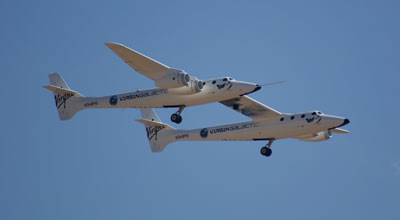 WhiteKnightTwo in flight over Las Cruces airport in June 2009. The landing gear is partially extended during this overflight. The AP reported late today that part of the landing gear for Virgin Galactic’s WhiteKnightTwo aircraft collapsed upon landing at the end of a test flight today at Mojave Air and Space Port in California. An FAA spokesman told the AP that the left main landing gear, the one that collapsed, was damaged, but he did not know if there was any other damage to the aircraft. SpaceShipTwo was not attached to the aircraft during Thursday’s flight.
Scaled Composites issued a brief statement about the incident, offering few details about what happened in the “minor” incident:
A minor incident occurred on the runway at Mojave airport this morning, which involved a mechanical problem with the left hand-side landing gear of WhiteKnightTwo. No injuries were sustained and the incident did not involve the Spaceship which was not attached to WhiteKnightTwo. WhiteKnightTwo was on its 37th test flight, and has been flying since December 2008. Further information will be posted in due course.
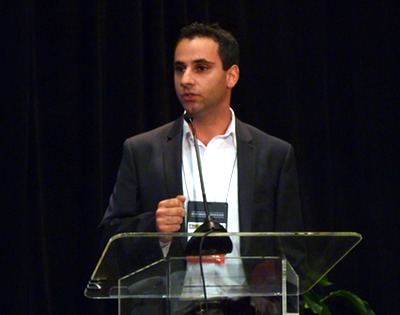 Enrico Palermo of Virgin Galactic discusses the company's development of SpaceShipTwo and WhiteKnightTwo at the NewSpace 2010 conference on Saturday. At the end of Saturday’s sessions at the NewSpace 2010 conference in Silicon Valley, Enrico Palermo, project engineering manager for Virgin Galactic, gave a brief update on the company’s activities. There weren’t any new announcements about the company’s efforts, nor (consistent with their past practices) predictions about future flights. Palermo did show video of their most recent captive carry flight, the first time a crew flew in SpaceShipTwo, as well as some new photos of work on SpaceShipTwo in Scaled’s facilities, showing the spaceplane’s wings rotated up in the feathering position that provides for the “carefree” reentry of the vehicle, in much the same way as SpaceShipOne.
Palermo did provide a few updated statistics about the company and the vehicle testing program. WhiteKnightTwo now has over 100 hours of flight time on 33 flights since the test flight program began in late 2008. SpaceShipTwo, meanwhile, has now flown three captive cary flights. On the business side, the company now has over 350 customers who have paid deposits ranging from $20,000 to the full $200,000, with a total of now over $50 million. Those deposits, he added, are held in escrow for now, and won’t be converted to company revenue until the tickets are formally issued.
Palermo also briefly discussed The Spaceship Company (TSC), the joint venture between Virgin Galactic and Scaled Composites that will manufacture the WK2 aircraft and SS2 spaceplanes. “This is a company you’re going to be hearing a lot more about over the next year or so,” he said. “We’re currently assembling a team of individuals to run TSC in Mojave; we’re recruiting like mad.” (There is a list of job openings on the TSC web site.) TSC is currently located in an existing building at Mojave Air and Space Port, but Palermo said there are plans to build a new final assembly hangar there.
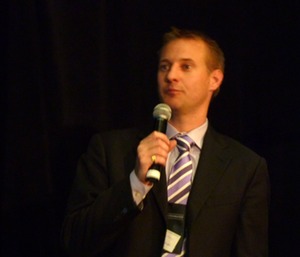 Tom Shelley, president of Space Adventures, updates NewSpace 2010 attendees on his company's suborbital and orbital spaceflight plans. Two months ago, at the International Space Development Conference in Chicago, Space Adventures announced a partnership with Armadillo Aerospace to develop vehicles for suborbital space tourism. At the end Friday of the first day of the NewSpace 2010 conference in Sunnyvale, California, Tom Shelley, the new president of Space Adventures, provided a brief review on the company’s suborbital plans. (Shelley took over as president about a month ago, he said; Eric Anderson is still there as chairman, but Shelley said he’s involved in more of the day-to-day activities of the company now.)
Shelley didn’t make any major announcements about the company’s suborbital efforts yesterday, instead primarily summarizing the plans to have Armadillo develop a vehicle that can serve what Shelley said could be a huge market: he noted that there are about 10 million people with investible assets of $1 million or more, and who could thus afford a $100,000 suborbital flight if they’re so inclined. Shelley went on to suggest that the fraction of those people who would be interested could be huge: he cited a survey of several hundred jet owners, 69% of whom said they’d be interested in flying into space. “There was no context to that,” he admitted, saying that survey didn’t describe what sort of spaceflight experience would be offered. “Even if it’s ridiculously wrong,” he said, offering something closer to 20% that had been noted in previous surveys, “that’s still a pretty good number.”
“There is a market, and we have barely scratched the surface,” Shelley said. One challenge the company has faced, he said, is describing what the spaceflight experience will be like for suborbital flyers, something that can be difficult to do since there are no vehicles flying yet. “What we’re missing is the actual flight, the actual moment where a real person, a real paying passenger, gets on the vehicle and we take them up into suborbital space,” he said. “At that point the market for sure is going to explode.”
Shelley also briefly discussed Space Adventures’ orbital plans, hinting that there are new developments coming soon. Asked why, given that Space Adventures has been able to readily fill seats on Soyuz taxi flights to the ISS when offered, it hasn’t yet flown a dedicated mission, Shelley said it came down to cost. “Selling expensive spaceflights is not easy,” he said. “When your price goes from $20 million to $35 million to more over the course of very short period of time, it’s a challenge to find customers who are prepared to put up that money.” However, he added, “The customers are there, and there’s going to be some fun announcements coming out of us in the next few months about future missions and future contracts that we have signed.”
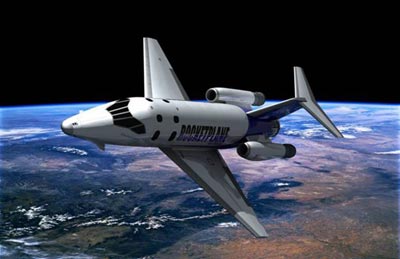
Rocketplane Global has been barely hanging on the last couple of years since its orbital counterpart, Rocketplane Global, lost its NASA COTS award and the financial crisis dried up the investment market. The company, in particular vice president Chuck Lauer, has been out there trying to drum up support for a variety of opportunities, from flights in Hawaii to, at the Space Access ’10 conference three months ago, a venture to use Florida’s Cecil Field for suborbital flights as part of a broader tourist attraction. However, time has run out for the company.
The Oklahoma Gazette reported today that Rocketplane, including its Rocketplane Global and Kistler subsidiaries, filed for Chapter 7 bankruptcy protection last month in Wisconsin, where the company was operating from after giving up its Oklahoma facilities. Unlike Chapter 11 bankruptcy, where the company can reorganize, Chapter 7 involves the liquidation of assets. Whatever is left of Rocketplane will be sold off to cover those debts.
According to the bankruptcy filings, linked to at the end of the Gazette article, Rocketplane Kistler has $108,250 in assets, primarily tooling and some components for the K-1 vehicle, and over $7.36 million in liabilities. (The filing notes a number of “aerospace patents” dating back to the original Kistler Aerospace, but puts no value on them.) Rocketplane Kistler claims $275,000 in assets, in the form of four used GE F-85 jet engines, as well as unvalued patents versus over $2.56 million in liabilities. The parent company, Rocketplane, declared no assets in its filing but nearly $3.7 million in liabilities. (Also included in the documents is a bankruptcy filing by Rocketplane owner George French, although he is also listed as a creditor in some of the company filings.)
“We did what we said we could do. Unfortunately, we did not complete the program as originally conceived,” French told the Gazette, in something of an understatement. The long saga of Rocketplane, which stretches back to the mid-1990s with the founding of Pioneer Rocketplane by Lauer, Mitchell Burnside Clapp, and Robert Zubrin, has come to an end.
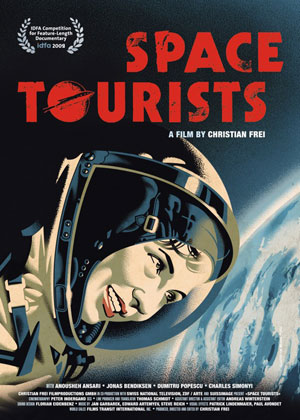
Earlier this week I got to see the film Space Tourists during a screening as part of the AFI Silverdocs film festival in Silver Spring, Maryland. This film has been out for some time but has been limited to the film festival circuit; it first appeared in the US at Sundance earlier this year and Ryan Kobrick wrote a good review of the film for The Space Review.
My own impressions of the film are mixed. Part of the film is about the spaceflight experience, in particular the flight of Anousheh Ansari, but as much or more is about life in Kazkhastan, with imagery of abandoned apartment blocks and crumbling infrastructure. The film follows a group of scavengers who travel out to where the first stages of the Soyuz rocket that launched Ansari fall back to Earth; they cut up the metal and sell it for scrap. At times the film juxtaposes the two: we see the metal collectors immediately pull out of the rocket stage a small tank that looks like a cooking pot so they can use it exactly for that—a pot to cook their meals in over an open fire. We then see Ansari and her crewmates on the ISS prepare their own prepackaged meals on the station.
Another portion of the film steps away from the ISS and Kazakhstan to look at the effort by one Romanian group, ARCA, led by Dumitru Popescu, to develop their own vehicles. ARCA competed in the Ansari X PRIZE and is a team in the Google Lunar X PRIZE; the film shows their efforts to loft a subscale rocket on a solar-heated balloon. It’s an odd choice for a film supposedly about space tourism: this particular ARCA effort isn’t directly about space tourism, while a number of other ventures are focused on space tourism and arguably making faster progress than ARCA.
The film is neither blatantly pro- or anti-tourism. In a brief Q&A session after the screening, director Christian Frei said he was drawn to the topic after reading a short newspaper article about Daisuke Enomoto, who had planned to fly to the ISS on a Soyuz flight. Enomoto was rejected for health reasons and Ansari, who had been training as his backup, took his place. Ansari provided him with the footage she shot while on the station for his documentary without any conditions, he said. That was a relief to hm, he said, since dealing with “billionaires”, as he put it, “was a challenge”. (Ansari is not quite a billionaire.)
One comment by Frei struck me late in the Q&A session. Asked about the inclusion of ARCA in the film, he said that he wanted to feature someone in the film who wants to go to space “with his own tools” instead of simply buying a ticket. “I love this guy and his dream of going and flying to the Moon as a Romanian,” he said. “This is the most expensive thing that you can imagine. And of course he won’t get there, but, you know, theoretically it would work.” In some sense he’s right: it is unlikely that the small, undercapitalized ARCA team will be able to land a spacecraft on the Moon as required for the GLXP; after all, the team was never able to develop a suborbital rocket for the original X PRIZE competition. But, unlike Frei, I’d be cautious about completely writing off ARCA or anyone else striving to turn a dream into reality.
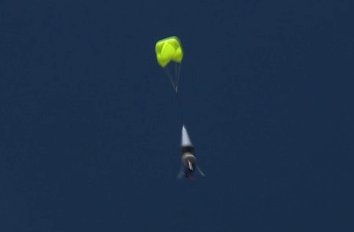 Armadillo's Mod vehicle descends under a drogue chute for several seconds before relighting its engine, in this screen capture from an Armadillo Aerospace video of Saturday's flight. First it was Masten Space Systems, who last month demonstrated an in-flight engine relight on their Xombie vehicle, and now it’s Armadillo Aerospace’s turn. On Saturday Armadillo flew a Mod vehicle on a boosted hop to an altitude of about 2,000 feet (600 meters), similar to flights they’ve done in the past. This time, though, they turned off the engine on the descent for about five to seven seconds before relighting, as can be seen in this video. One difference between the Armadillo and Masten flights is that the Mod deployed a drogue during the time the engine was off, apparently to keep the vehicle from tumbling; it worked, although the vehicle did appear to swing around quite a bit. Once the engine was reignited and the drogue released, the vehicle made a normal descent and landing under rocket power.
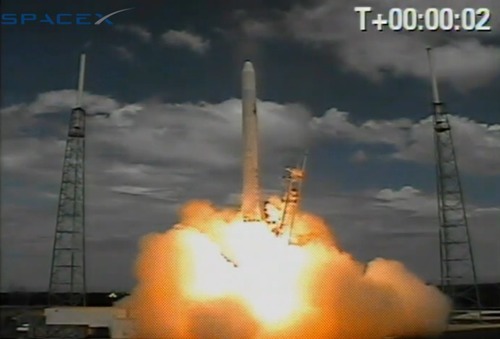 The Falcon 9 lifts off at 2:45 pm EDT Friday from Cape Canaveral, as seen in this screen capture from the SpaceX webcast. If you had polled the attitudes of the people watching the launch of the first Falcon 9 on Friday, the most common feeling leading up to liftoff might be something like “hoping for the best but expecting the worst”. People wanted SpaceX to succeed with the Falcon 9 on Friday, but know that first launches of new rockets had no guarantee of success—something that Elon Musk and SpaceX impressed upon the community leading up to the launch.
So when the Falcon 9 lifted off at 2:45 pm EDT today and soared into the skies, eventually placing a demonstration Dragon capsule into nearly the planned orbit, the reaction was something approaching euphoria, even by Musk himself. “It’s been one of the best days of my life,” he said in a teleconference with reporters a couple of hours after the launch. “It’s certainly been one of the greatest days for the people of SpaceX.”
The launch had some drama, as well. The launch window opened at 11 am, but because of problems with an antenna for the rocket’s newly-approved flight termination system, they weren’t ready to launch until 1:30 pm. In the final seconds of the countdown, though, just as the nine rocket engines were about to ignite, the launch was aborted.
Musk said the abort was caused by a reading from an igniter on engine number three on the first stage. “The pressure rise on engine three was higher than expected,” he said, triggering the abort. “We looked at the data and concluded that… we were being a little too conservative” in the allowable values for the pressure in the engine. “So we widened that band [of allowable values], reconfigured the engine three computer, and it lifted off without a problem.”
About the only discernable problem during the launch was a roll in the second stage that appeared to speed up as the burn continued. “There was a little more roll than expected. It didn’t affect the mission,” Musk said. “That is definitely something that we want to refine,” he said, adding they didn’t immediately know the reasons for the roll.
So how did the launch feel, Elon? “When the rocket achieved orbit, there was tremendous relief and elation at SpaceX,” he said. “Upon liftoff there was sort of relief that it cleared the pad; things were obviously extremely tense here.” And his plans to celebrate? “I think with a lot of margaritas.”
After consuming those drinks, Musk and his team plans to spend about a month reviewing the data from the launch to fully characterize it and look for any issues (in addition to the second stage roll) that need to be corrected. Musk said he still planned to launch the next Falcon 9 mission, the first of three planned NASA COTS missions, later this summer. The Falcon 9 for that mission has already been built and is sitting in Texas ready to ship to the Cape; the Dragon spacecraft that it will launch is undergoing final reviews.
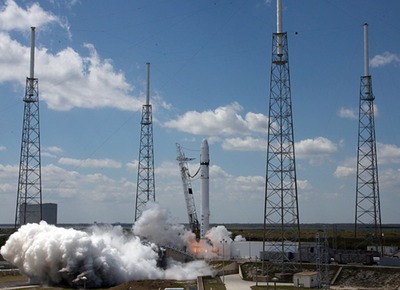 Falcon 9 on the pad at Cape Canaveral for a static test firing earlier this year. If all goes as planned, SpaceX’s Falcon 9 rocket will lift off Friday from Cape Canaveral on a mission to demonstrate the capabilities of the new launch vehicle. However, the problem with new launch vehicles is that things often don’t go as planned, a concern not just for SpaceX but for the broader commercial spaceflight industry at a key time for it.
SpaceX CEO and CTO Elon Musk was well aware of the difficulties of launching new rockets, something he and SpaceX have already gone through with the smaller Falcon 1, which failed to reach orbit on its first three launches. “Historically, I think it might be something like a 50/50 shot of the first flight succeeeding,” he said in a teleconference with reporters Thursday, referring to the historical record of first launches of new rockets.
He does feel a little more optimistic about the chances of success with Falcon 9, citing the company’s experience and heritage of some Falcon 9 components on the Falcon 1. “My personal assessment of the likelihood of success is probably 70-80 percent,” he said. He did have a colorful way of putting that into perspective. “I should point out that this is less than the probability of success in Russian roulette,” he noted. (Assuming success in Russian roulette is defined as not getting a bullet, you have a 5 out of 6, or 83%, chance of getting an empty chamber.) “So if anybody remembers that scene from The Deer Hunter, that’s tomorrow.”
Well, that’s one way to look at it. It’s also worth noting that success is not a binary condition for this test flight: there’s a spectrum of outcomes between complete success and complete failure. “One hundred percent success would be reaching orbit” with the model of the Dragon spacecraft the rocket is carrying, Musk said. “But I think that, given that this is a test flight, whatever percentage of getting to orbit we achieve would still be considered a good day.” He added it would be a “great day” if both stages work correctly.
SpaceX is finally ready to launch the Falcon 9, having overcome the last obstacle to launch, the certification by the Air Force of a flight termination system that would be used if the rocket veers off course and has to be destroyed. Getting that approved took much longer than SpaceX anticipated. “There were I think some elements of it we underestimated, some elements that our suppliers underestimated,” he said.
If this launch was just about SpaceX it would be one thing: the company has been through the process of developing and testing a launch vehicle before, and from their accounts seem prepared for a failure, either partial or total. However, the launch also comes at a time when commercial spaceflight has been thrust into the political spotlight by plans by the Obama Administration to have NASA rely more on commercial launch providers, including a $6-billion initiative to develop commercial crew capabilities. That has put a lot of scrutiny on this launch from those skeptical of, or outright opposed to, the president’s plans.
“I feel like sort of a political punching bag, a whipping boy, I suppose,” Musk said. “The opponents of the commercial approach have taken a very calculated strategy of attacking SpaceX” while ignoring alternative vehicles, like United Launch Alliance’s Atlas 5 and Delta 4 rockets, that have already demonstrated the ability to safely launch spacecraft on more than 30 missions since 2002.
The Falcon 9 launch, he continued, “should not be a verdict on commercial space. Commercial space is the only way forward” because of the unsustainably high costs of government programs. He later said that “if some company like SpaceX doesn’t succeed, then the future of space is not a bright one.”
SpaceX will be webcasting the launch starting at 10:40 am EDT (1440 GMT) Friday, 20 minutes before the four-hour launch window opens. They also have the same time block reserved on Saturday should the get scrubbed Friday by technical issues or the weather. In addition, Spaceflight Now will have its own webcast featuring Miles O’Brien, David Waters, and former astronaut Leroy Chiao starting at 10 am EDT.
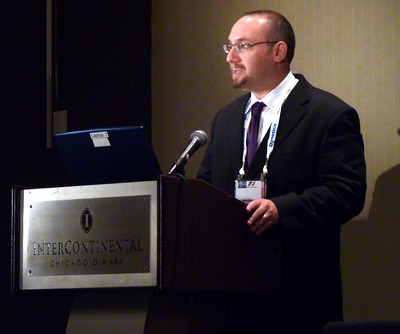 Mike Gold talks about Bigelow Aerospace's plans at the ISDC in Chicago on Friday. Mike Gold, director of Washington operations for Bigelow Aerospace, spent much of his 45-minute speech at the International Space Development Conference (ISDC) in Chicago talking about the history of Bigelow’s development of inflatable (or, as the company prefers, “expandable”) modules, including the successful launch of Genesis I and II in 2006 and 2007, respectively; familiar ground for most who have followed the company. He also discussed the company’s future plans, including how NASA’s proposed new direction in human spaceflight may directly and indirectly affect the company.
Bigelow’s plans to launch a series of larger habitable modules, starting with the 180-cubic-meter Sundancer, are dependent on the introduction of commercial crew transportation services, a key element of that plan. “The long pole in the tent for our operations is that while we could have Sundancer ready very quickly, we don’t have a way to get people back and forth,” he said. Without it, the company’s investment “will be for naught”. He believes that commercial crew services will be as safe, if not safer, than government systems, as companies have a lot more riding on the line than a government agency: while NASA could (and has) survived fatal accidents in the past, a company could lose hundreds of millions of dollars or go our of business entirely in such an event. “We’re more incentivized to be safe than a government agency because we have a lot more riding on it.”
However, Bigelow is a bit particular about who they work with on commercial crew. “We love SpaceX,” he said, “but the rocket we’re most excited about, at least in the near-term, is the Atlas 5.” He cited the rocket’s 100-percent record of success since its introduction in 2002 as the reason they prefer it over the as-yet-untried Falcon 9. “If your goal is safety and reliability, this is the system you would go to.”
Another area where NASA’s new plans intersect more directly with Bigelow’s plans is the agency’s focus on “flagship technologies”, including inflatable modules. “The good news is that NASA is paying attention to the technology,” Gold said. “The bad news is that NASA is paying attention to the technology.” He said the company would be responding to a new request for information (RFI) from NASA on the proposed technology demonstration program, and that Bigelow has been “actively” talking with NASA about building something called a “Bigelow Aerospace Module”, or BAM, that could be installed on the ISS.
One criticism the company has of NASA’s interest in inflatables is that the RFI talks about adding a “full scale” module to the station. He said even adding a small module to the station involves a lot of issues such as structural fatigue and outgassing. “I’m not sure whether you could safely put a full-scale inflatable on the ISS,” Gold said. A free-flyer would be much safer and cost effective, he said. Asked after his presentation whether there was the feasibility and/or interest in putting a Sundancer module on the ISS, he again raised the technical concerns about adding a relatively large module to the station. The BAM concept would be closer in size to the Genesis demonstration modules, he said, more like “a closet” than a full-fledged module.
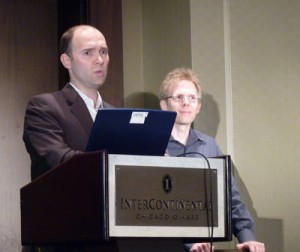 Eric Anderson (left) and John Carmack talk about their suborbital partnership at ISDC on Thursday. As expected, Space Adventures announced Thursday at the International Space Development Conference, (ISDC) in Chicago its partnership with Armadillo Aerospace to provide suborbital space tourism flights. Armadillo will develop a vertical takeoff, vertical landing (VTVL) suborbital vehicle carrying people to at least 100 kilometers altitude, with Space Adventures selling the seats, starting with its existing customer list of about 200 people, including several former astronauts.
The presentation, featuring Space Adventures president and CEO Eric Anderson and Armadillo Aerospace founder John Carmack, offered few technical or schedule details about their plans. There is no finalized vehicle design yet: a video shown in the presentation showed a number of differenent Armadillo concepts, from a cone sitting atop four propellant tanks with a central engine to the “fishbowl” concept Armadillo showed off in 2008 for the short-lived suborbital joint venture between Armadillo and the Rocket Racing League. Carmack also offered no timetable for the beginning of tourist flights, although he did note the company hoped to be flying unmanned scientific payloads to altitudes of approximately 100,000 feet (30 kilometers) in the next year, and to 100 kilometers altitude in the following year.
Instead, the presentation was examining in more general terms the companies’ plans, including why Space Adventures, who has made a name for itself for nearly a decade by arranging flights to the International Space Station, would get into the suborbital spaceflight business. Anderson noted that when Space Adventures was founded in the late 1990s, its focus was on suborbital spaceflight at a time when many vehicle developers were saying “we’re only two years away,” he recalled. “We didn’t have any idea at the time that we would be fortunate enough to be able to launch private citizens to orbit before suborbital flights,” he continued. Later, Space Adventures considered working with a Russian company to develop a suborbital vehicle called Explorer, which he said they abandoned because “frankly, it got too expensive.” As Armadillo made progress with their vehicles, “I was just so impressed” with their efforts he was convinced they were the company that could really reduce the cost of space access.
While neither Armadillo nor Carmack discussed the cost of the project, they did confirm that Space Adventures was providing Armadillo with funding to support it, at least in part. Alluding to past partnership announcements that failed to pan out, Carmack said, “One of my new rules on this is that I’m not going to get up and talk about something unless a check has cleared.” And since Carmack was getting up and talking about this, he confirmed, “Space Adventures has actually paid Armadillo Aerospace to begin developing a new suborbital vehicle.” Carmack said later that under their agreement, Space Adventures will pay Armadillo unspecified amounts upon achiveing certain milestones in the vehicle development effort. “The amount of money that has changed hands here is not trivial, but it’s not enough to fund the vehicles,” he said. “It isn’t enough money to pay for these vehicles, it’s enough money to make me think about not pursuing other contracts.” He added that he expected to kick in more of his own money into the venture, but also looked to getting funding from NASA’s Commercial Reusable Suborbital Research (CRuSR) program for flying scientific payloads.
The timelines that they did reveal suggest that Space Adventures and Armadillo will not be the first to market for commercial suborbital space tourism, given the progress being made by companies like Virgin Galactic and XCOR Aerospace. Carmack addressed this as well, in the process perhaps raising the hackles of some of his competitors in the audience at the ISDC. “It’s a fool who doesn’t think he has any competition,” Carmack said. On Virgin, he said, “I think they have explicitly not chosen the most cost effective solution on this. I don’t think they will be able to compete on price, eventually, but some people will prefer their experience.”
Carmack was critical of XCOR from a funding standpoint. “I believe that, if fully funded, they could build a vehicle that could fly, that could service passengers,” he said. “I do not believe they are fully funded.” He then issued something of a warning to other companies, after earlier noting that Armadillo planned to accelerate its development plans and hire more people. “I think one of the best things about having the other companies in the industry is that it’s developed some very skilled and talened people, and we’re probably going to steal some of them.”
Carmack also said he felt Armadillo’s VTVL vehicle was a superior approach to a winged vehicled like SpaceShipTwo or Lynx. A ballistic reentry, he said, is better than a winged reentry, noting one fatality from the X-15 program. Launching a winged vehicle, he added, is “a lot harder than making a ballistic vehicle fly right up.” Thus, for greatly reducing the cost of suborbital spaceflight, “the powered [vertical] landing has significant benefits.” After the presentation I talked briefly with XCOR COO Andrew Nelson, who said, “People will want a lot of different experiences. We believe that most people will want something involving wings.”
|
|











Recent Comments